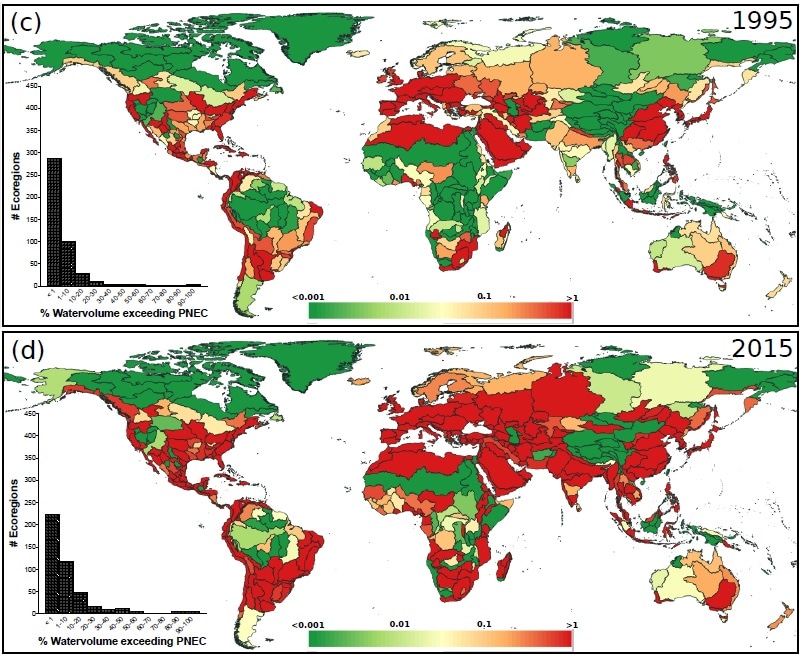Feb 25 2019
An investigation by environmental professionals at Radboud University has revealed that in the last 20 years, there has been an increase in pharmaceutical concentrations in freshwater sources across the globe.
 The environmental risks of ciprofloxacin in freshwater have increased worldwide between 1995 and 2015. PNEC stands for “predicted no effect concentrations.” (Image credit: R. Oldenkamp et al., Environmental Research Letters)
The environmental risks of ciprofloxacin in freshwater have increased worldwide between 1995 and 2015. PNEC stands for “predicted no effect concentrations.” (Image credit: R. Oldenkamp et al., Environmental Research Letters)
The increased levels of ciprofloxacin, an antibiotic, may cause adverse ecological effects. This was the first study, reported in Environmental Research Letters on February 22nd, 2019, to determine the risks of two specific drugs in worldwide freshwater sources.
The study calls for more widespread data gathering to measure the problem around the world. Getting an accurate picture of the environmental risks of pharmaceuticals around the world depends on the availability of data, which is limited. It’s true that there are models, such as the ePiE model, which can give detailed predictions of pharmaceutical concentrations in the environment, but these are often only applicable to places where we already have a lot of information, such as rivers in Europe.
Rik Oldenkamp, Study Lead Author, Radboud University.
A new model created by the scientists, which is an enhanced version of the current model with a lower resolution, helps in achieving global predictions for particular ecoregions.
Damaging Concentrations
The environmental risks for the two drugs examined in this research—ciprofloxacin (an antibiotic) and carbamazepine (an antiepileptic drug)—were found to be 10–20 times greater in 2015 than in 1995. Overall, the increased human use of ciprofloxacin has been found to have a significant impact on the environment.
The concentrations of this antibiotic can be harmful for bacteria in the water, and these bacteria in turn play an important role in various nutrient cycles. Antibiotics can also have a negative impact on the effectiveness of bacteria colonies used in wastewater treatment.
Rik Oldenkamp, Study Lead Author, Radboud University.
Antibiotic Resistance as an Environmental Issue
For a long period, antibiotic resistance has been on the agenda of the World Health Organization (WHO) and United Nations General Assembly.
Generally, it’s seen as a problem for the health sector, as resistant bacteria can be spread within hospitals or through livestock. But there’s little awareness of the role of the environment in this problem, even though it becomes increasingly clear that the environment functions as a source of resistance for various pathogens.
Rik Oldenkamp, Study Lead Author, Radboud University.
More Data in High-Risk Areas
“Our model predicts a relatively high environmental risk for ecoregions in densely populated and dry areas such as the Middle East, yet those are precisely the areas where there is little data on pharmaceutical use and concentrations in surface waters,” stated Oldenkamp. Human pharmaceutical consumption in these areas has been predicted by the scientists using regression models based on the consumption in other countries, including socioeconomic and demographic data. The researchers combined these data with other factors, namely, water sources and the number of people who had access to wastewater treatment.
“Our model shows a particular need for new data in these types of areas. The model is really a starting point for creating an insight into the environmental risks posed by pharmaceuticals all over the world,” stated Oldenkamp.